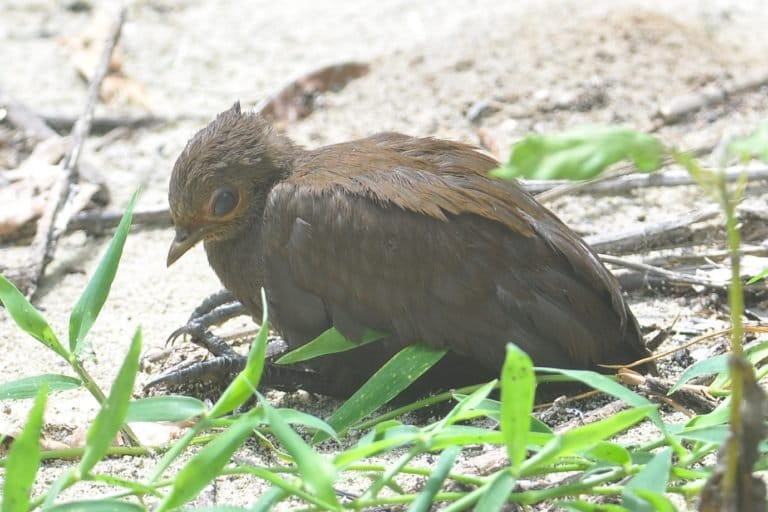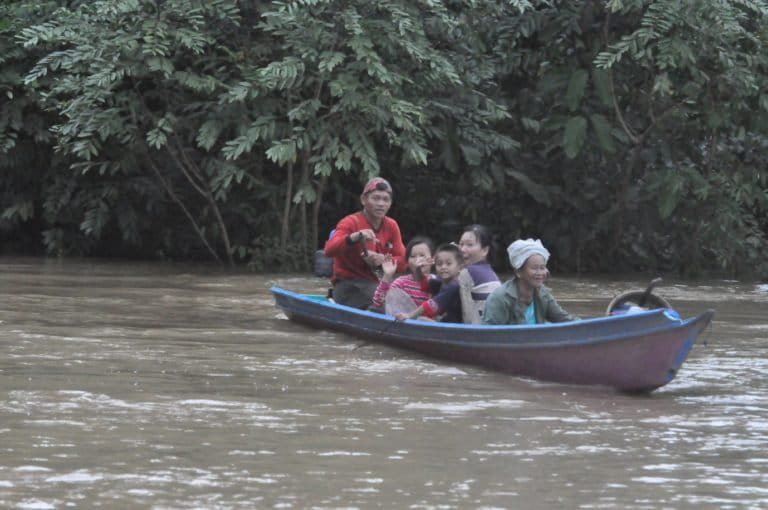- With funding from National Geographic we are retracing the footsteps of Henry Cushier Raven, a specimen collector who travelled extensively in East Kalimantan, Indonesia between 1912 and 1914.
- We want to know which species Raven found and whether we can still find these species today.
- In April 2016, we already covered the Berau and East Kutai parts of Raven’s journey. This is the story of his Mahakam travels.
- The story is published in four parts. This is the final part.

Continued from part III.
After four days of sailing up the fast-flowing Mahakam we arrive in the village of Laham, not far from the end point of Raven’s trip. In Raven’s time there was a Catholic mission school in the town “with an attendance of about seventy Dayak boys”. The school building still stands today, as does the church which recently celebrated its centennial anniversary. Raven had several dinners with the Dutch pastor, father Goossens, who was stationed here. We ask the people whether they remember or know stories of this priest, or even Raven himself, but too much time has passed. But they do tell us that two Dutch missionaries are buried in the local cemetery. And indeed, we find their gravestones next to each other. Sister van den Heuvel, born in the Netherlands in 1877, died in Laham in 1926. Brother Lauwers, born also in the Netherlands, died before his 30th birthday in 1928. Whether or not they could have met Raven is not clear.

This village is interesting because it is among the very few in the upper Mahakam area what have said ‘no’ to oil palm. Talking to village elders, it is clear that the people here feel strongly about maintaining their rights to their own farm land and access to forest and its wildlife. Selling out to oil palm could mean losing these traditional ways of life in exchange for cash or a job in the oil palm plantation. These are tough choices that every village here is facing. It is disconcerting that so few are following the example of Laham in rejecting oil palm development. Oil palm is a highly productive crop, producing far more vegetable oil per land unit than any other vegetable oil crop – think maize, rapeseed, coconut, soy. But oil palm also has major environmental and social costs that are too often ignored in development planning.
On the final leg of our trip, we go upriver a little further to Raven’s real end point: Muara Merah. I talk to Pak Juk, a local Punan hunter. The Punan people are the former forest nomads of Borneo. Until the 1960s, they had no villages, but lived in temporary settlements in the forest. Wherever the sago palm, their main staple, was ready for harvest, they stayed, and once the crop was exhausted they moved on. Pak Juk was born in the forest in the 50s or 60s – he is not quite sure when. Not until the 1970s did he permanently move to the actual village of Muara Merah. Unlike the people in Laham, the people here have welcomed oil palm.
But what Pak Juk tells me is disconcerting. Normally there is some benefit-sharing agreement between a village community and the oil palm company. The village is paid an agreed percentage of the palm oil harvest, but Pak Juk tells me that he knows nothing about the details of the agreement. I just hope for him that the deal is a good one, because the oil palm company has now cut down most of the forests in their village area, wildlife is really scarce, and the plantation work is actually done by outsiders from the island of East Timur, thousands of miles from Kalimantan. What benefits will actually accrue to the people here, and who in the village will receive them, the powerful or also the powerless? What will they gain or lose from the oil palm deal?

One bit of information from Pak Juk comes as a real surprise to me. He talks of a population of orangutans in the upper Merah area. This would be a new discovery, because at the moment the distribution maps of this great ape shows it to be absent from this area. I have surveyed Kalimantan’s orangutans since the early 1990s and thought we knew pretty well where they occur, so this is exciting news. And Pak Juk is certainly not confusing the orangutan with another species. He describes how the large red-furred animals rip open sago palms to feed on palm hearts, and no other primate would have the enormous strength needed to do that.
The good news is that the nomadic Punan who used to hunt these orangutans have now settled down river. This might give the slow-breeding orangutan some respite from past hunting and a chance for the population to recover. This hunting pressure was also clear to Raven who wrote about the Merah area that “the country here is all hilly and heavily forested but game is very scarce”. Only through new surveys could we find out whether indeed the orangutans are there and recovering.

This survey does not really prove it, but Borneo’s wildlife seems to have declined a lot over the past century. Of course, Raven was shooting animals, while we are just watching and listening out for them. Raven sometimes spent weeks in one site, while we often stay for a day or less. Still a lot of the species that were collected by Raven do no longer occur in the same sites. Some, like the straw-headed bulbul, a highly popular cage bird which Raven collected near Samarinda city, are now nearly extinct in the wild. Others, like primates, are increasingly rare through a combination of forest loss, and, especially in the upstream areas, over-hunting. And then there are species like the white-shouldered ibis that have managed to become so rare before we even had time to properly study it. We have no idea what is driving its decline. The overall message is clear: Borneo’s wildlife is being squeezed from all sides, and no easy solution exists to turn the tide.

There is hope though and I remain optimistic that the tide can be turned. As I write this, we are looking at a group of 12 black hornbills feeding in riverside trees. We saw seven large otters in the river this morning. In some of the more pristine forest with limited hunting pressure we managed to find more than 80% of the species that Raven collected 100 years ago. People and their governments will realize one day that you can only mess with nature that much before it starts biting back. Communities that we interviewed for this survey complain about increasingly frequent and severe floods. They tell us how much hotter it is now that the forests are being cut down. They find it much more difficult to catch fish or hunt pigs and deer, their main sources of free protein. Borneo has many different possible futures, but some futures are really much better for everyone than others. We can only hope that people see these paths to better futures before it is too late and those futures become impossible.
PART I | PART II | Part III | Part IV of IV
Detailed species lists are available here.
Erik Meijaard coordinates the Borneo Futures initiative. Follow @emeijaard and @borneofutures.
